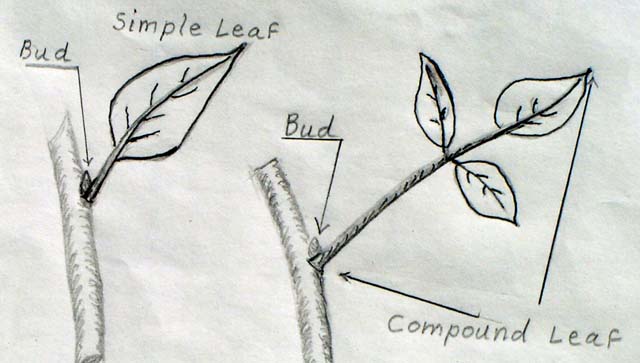Observation:
A Leaf Collection
Introduction:
A very important job of the field biologist is to collect specimens
and preserve them for comparison and study in the laboratory. It
is also important to keep field notes with each specimen telling where
and when it was collected, and any other information that might be
helpful later. For this observation project you are going to get
leaves from many trees and bushes, preserve them for study in later
projects.
Field activity:
Use a folder, or other means for keeping the collected leaves flat as
you carry them.
From each tree (or bush, shrub) in the study area; take several leaves
[
How to know it's a leaf] which are mature (not
still growing) and not
chewed on, or damaged.
Write notes about the tree; Its location, name of the tree if you know
it, otherwise a description and or sketches that will help to find its
name later. [
How to find
a name]
Laboratory
activity:
Preserving the specimens, most leaves, except for those which are very
thick and moist (succulent), can be dried and mounted on pages for easy
study later.
A. Place several layers of newspaper on a flat surface where it
can remain for weeks, or on a board which can be moved without
disturbing the stack.
Spread paper towel over the newspaper.
Place some of the leaves on the towel, don't crowd them,
make sure they remain flat.
(Be sure you have a note
with each leaf, maybe just a number referring the entry in your field
notes, with each leaf so that you will be sure to remember the
information that goes with it.)
Place another towel over the leaves.
Next, more layers of newspaper.
Continue alternating layers of leaves and newspaper until
all of the leaves are included.
On top of the last layer of newspaper place a flat
weight. A stack of books is commonly used (Get your money's worth
out of that old encyclopedia.), or a board with bricks or rocks on it.
B. Every two to three days change the paper towels, until the
leaves seem pretty well dried.
Then leave them in the press for another week, and until
you are ready to mount them.
C. Arrange two leaves on a page, one with the top side up
and one with the bottom side up. If the tree has leaves of more
than one shape, include others to show the variations.
Fasten each leaf to the page with transparent tape.
Write the information about the tree on the page.
Name (see: Finding the name of a tree.), location, date collected, and
anything of interest.
Level one. Organize the
pages in one, or more loose leaf notebooks
for easy reference in the future for more advanced projects.
Level two. Arrange the
pages in order according to the shapes of the leaves.
Level three. Using
reference
books for helpful vocabulary, write a description of the shape of each
kind of leaf, as completely as you can.
[Top of Page]
[Return
to Menu] [ Home
]
==============================================================
How do I know that it is a leaf?
It is easy to mistake a
leaflet
of a compound leaf for a whole leaf. Remember, where the petiole
(leaf stalk) of a leaf is attached to the stem (branch) of the plant,
there is a bud.

==============================================================
I already know the names of some trees and shrubs, so those are easy,
but for most I don't know a name. So, what do I do?
I ask people who might know, when that's convenient. Sometimes
they know and sometimes they don't, that's ok (Remember that a tree may
have more than one common name.)
When I walk through nurseries and garden departments, I look for trees
like the one I'm interested in, and read the tags.
I look through books (Use the library, don't buy your own until you are
sure you really want to continue the study.), field guides to trees and
shrubs, gardening books.